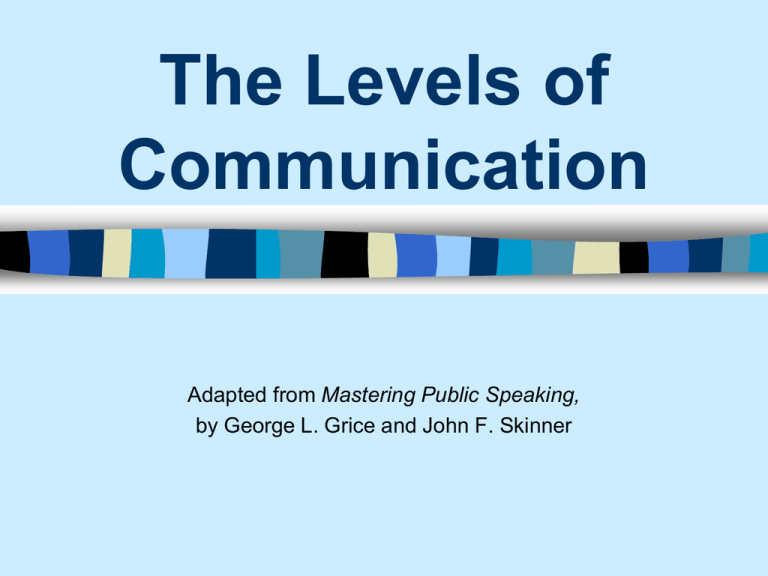The Levels of Communication
advertisement

The Levels of Communication Adapted from Mastering Public Speaking, by George L. Grice and John F. Skinner To Communicate . . . The Latin verb communicare means “to make common to many, share, impart, divide.” Simply stated . . . When you communicate you share, or make common, your knowledge and ideas with someone else. Communication, then, is the sharing of meaning by sending and receiving symbolic cues. Charles Ogen & I. A. Richard’s Triangle of Meaning The interpreter – The person who is communicating, with words or symbols The symbol – Anything to which people attach or assign a meaning The referent – The object or idea for which the symbol stands The Triangle of Meaning Interpreter (Speaker or Listener) Symbol ……… Referent Five Levels of Public Speaking: Five Levels of Public Speaking: 1) intrapersonal Intrapersonal Communication The type of communication a person has with himself, thus the prefix “intra-” which means within. As soon as a human being awakens, he begins an internal thought process and dialogue, almost always silent, but sometimes aloud. Five Levels of Public Speaking: 2) interpersonal Interpersonal Communication Interpersonal communication takes place between two people. This type of communication varies depending on the relationship between the two individuals. Five Levels of Public Speaking: 3) group Group Communication Group communication occurs when three or more individuals, who have a common goal, interact either formally or informally. Five Levels of Public Speaking: 4) public Public Communication Public communication takes place when one or more individuals communicate with a large group in a more “onedirectional” approach. Five Levels of Public Speaking: 5) mass communication Mass Communication Mass communication occurs when extremely large groups receive information, like a television audience watching a news broadcast, as well as the intermittent commercial advertising. Five Levels of Public Speaking: 1) intrapersonal 2) interpersonal 3) group 4) public 5) mass communication Linear Model of Communication Linear Model of Communication The speaker—the sender, the encoder, or source of the message. The Speaker Linear Model of Communication Encoding—the process of putting ideas into symbols to carry a message. The Speech Text The Speaker Linear Model of Communication Message—ideas communicated verbally and nonverbally. The Message The Speaker A speaker sends a message to a listener. Linear Model of Communication Listener—the receiver or decoder of the message The Message The Speaker A speaker sends a message to a listener. Linear Model of Communication Decoding—the process of attaching meanings to symbols received. Decoding The Message The Speaker A speaker sends a message to a listener. Linear Model of Communication The speaker—the sender, the encoder, or source of the message. Encoding—the process of putting ideas into symbols to carry a message. Message—ideas communicated verbally and nonverbally. Listener—the receiver or decoder of the message Decoding—the process of attaching meanings to symbols received. Linear Model of Communication The Speaker The Message A speaker sends a message to a listener. The Listener Problems with Linear Model of Communication #1—The assumption that a person is either the sender or a receiver of messages. Actually, we perform both of these roles simultaneously. Problems with Linear Model of Communication #2—The suggestion that communication involves only one message. Actually, there are as many messages as there are communicators involved, and the message the sender intends is never identical to the one received. Interactive Model of Communication When scholars began to see the limitations of the linear model of communication, they added other components to the speaker, message, and listener making a total of 7 components: channel, feedback, environment, and noise Interactive Model of Communication Channel—the medium, or the way the message is sent. Interactive Model of Communication Feedback—includes all messages, verbal and nonverbal, sent by listeners to speakers. Interactive Model of Communication Environment—the physical setting and the occasion for communication. Interactive Model of Communication Noise—anything that distracts from effective communication; some form of noise is always present. Interactive Model of Communication Channel—the medium, or the way the message is sent. Feedback—includes all messages, verbal and nonverbal, sent by listeners to speakers. Environment—the physical setting and the occasion for communication. Noise—anything that distracts from effective communication; some form of noise is always present. Noise Physical noise—distractions originating in the communication environment. Noise Physiological noise—distractions originating in the bodies of communicators—cold, headache, hunger, fatigue. Noise Psychological noise—distractions originating in the thoughts of communicators—anxiety, daydreaming, worry. Noise Physical noise—distractions originating in the communication environment. Physiological noise—distractions originating in the bodies of communicators—cold, headache, hunger, fatigue. Psychological noise—distractions originating in the thoughts of communicators—anxiety, daydreaming, worry. CHANNEL Message SPEAKER LISTENER Decoder Encoder Decoder Encoder Feedback CHANNEL Interactive Model of Communication The Levels of Communication Adapted from Mastering Public Speaking, by George L. Grice and John F. Skinner











